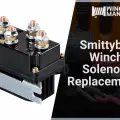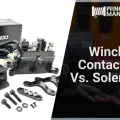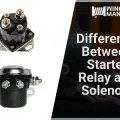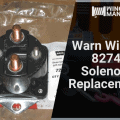There are a lot of electrical components in a winch. Each of these components make is essential to a smooth operation. However, there are other parts that are more vital – they provide more than smoothness and efficiency in the the function of the winch.
Such parts include (but are not limited to) the motor, the drum, and of course the solenoids. These are parts are more essential in that the winch wouldn’t really work wihout these parts.
The motor, for example, provides the power of pulling to the winch. Without it, the winch wouldn’t do any pulling anytime soon. Without the drum, the motor can’t do any pulling without damaging itself and the winch cable. And without the Warn solenoids… well, what does the Warn solenoid do, really?
Let’s find out!
At a Glance
What are Warn Winch Solenoids?
Winch solenoids are electromagnetic switches. How are they different from the winch switch? The solenoids are used to activate the winch motor by delivering the exact amount of current. It controls the current that flows into the motor to avoid damaging it.
This means that if just one of the four solenoids (the number of solenoids in winches vary from models to models) in your winch is faulty, your winch might suffer some motor damage.
The winch switch sends current from the battery to the solenoid. The solenoid redirects this current to the motor. The motor then turns the winch drum. There are dedicated solenoids for each turning of the motor. In high quality winches, two solenoids are used for reverse and another pair for forward.
You can tell that the solenoids are working by the clicking sounds they make. But what if you can hear that tell-tale clicking sound but the winch drum is not working?
Warn Winch Solenoid Just Clicks
There are a few possibilities when your Warn winch solenoids just click but the motor doesn’t work.
Within each solenoid are little materials called contacts. The solenoid bump these contacts together in order to deliver the correct current to the motor. These contacts bumping into each other are what causes the clicking sound you hear.
If you hear the Warn winch solenoid clicking, it means that it working properly. The problem, then, could be any of the following:
- Dirty or pitted contacts – dirty or pitted contacts may cause them to lose their ability to deliver current.
- Bad connection – a bad connection between the solenoid and the motor may mean that the solenoid can’t deliver the current to the motor.
- Faulty wiring – if the wiring has rusts or is damaged, the solenoid’s capacity to deliver current to the motor is compromised.
Checking Your Warn Winch Solenoids
- Check all of the connections from the winch solenoid to the motor. Look out for damages in the wiring and make sure that the terminals are clean and properly connected.
- If there are damages to the wiring, replace or repair the wires. If the terminals are corroded, clean them with a wire brush or replace them entirely. If one of the terminal connections is loose, rectify it.
- Disconnect the cables from the solenoid so you can unscrew the solenoid cover. Examine each connection in the solenoid. Make sure they are secure.
- Once every connection is in the ebst condition, try switching the winch again. See if you are getting power to the motor using a voltmeter. The motor should have a 12 volts reading.
- If there is no power getting to the motor, examine each connection to the solenoids. As was mentioned above, there are more than one solenoids on a winch. Check all of them.
- Check the motor again. All three motor terminals should have a 12V reading when activated.
- If it still does not work, the problem may be the motor is broken. You know that the winch solenoids are working if they are making the clicking sounds. This means that everything from the battery to the winch switch to the solenoids are in working condition.
If the motor seems to be the problem, you can try repairing it yourself or get a professional to repair ir for you. Another option is to buy a replacement. It is not advisable for you to repair the motor by yourself if you don’t have any experience. You might just do more damage.
To totally confirm whether the motor is the problem, you can try bypassing the winch solenoid.
Bypassing Warn Winch Solenoids
Here is how you can test and bypass a Warn winch motor.
- Put the winch in freespool mode
- Disconnect the positive connection from the battery. The ground conenction should be left alone.
- Disconnect the three cables on the three posts on the motor. Make sure you label the cables so you can reconnect them to the right posts later on.
- Each of the three posts on the motor has a label, “A”, “F1”, and “F2”. Using a small jumper wire (8 ga works fine), connect the “A” post to the “F1” post. Then connect the battery to the “F2” post. The motor should turn in one direction.
- Then try connecting “A” to “F2” and connect the battery to “F1”. The motor should turn the opposite direction now.
If you follow these steps, you can know whether your Warn motor is operational or not.
Learn to Diagnose Your Winch Problems
It is important, as a Warn winch owner, to learn to diagnose its potential problems if it is not working properly. Warn is one of the most expensive winch brands. And repairs may cost you a fortune if warranty does not cover your problem.
However, if you tamper with your Warn winch and damage it even more, it would cost you a lot more. So if your Warn winch solenoid just clicks, make sure you follow these instructions to the letter. You don’t want to make a mistake.
We offer tons of winch-related advice and instructions. Here are a few you might be interested in:



